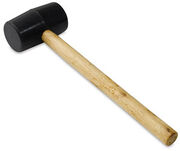A Mallet is a kind of hammer, often made of rubber or sometimes wood, that is smaller than a maul or beetle and usually with a relatively large head. Athough much bigger than a hammer. Used mainly for demolishing. This could easily smash most things up, though it is heavy.

A Rubber Mallet as shown here
There are many different variants of Mallets, for example: court mallets used by judges in court. Down below are examples of types of mallets that come in different types, the most common of which are:
- Rubber mallets are used when a softer blow is called for than that delivered by a metal hammer. They are typically used to form sheet metal, since they don't leave marks and are softer, as well as for forcing tight-fitting parts together, for shifting plasterboard into place, in upholstery, and a variety of other general purposes, including some toys. It is a tool of preference for wood workers using chisels, with plastic, metal or wooden handles - as they give a softened strike with a positive drive. It is the most commonly used mallet.
- Wooden mallet, usually used in carpentry to knock wooden pieces together, or to drive dowels or chisels. A wooden mallet will not deform the striking end of a metal tool, as most metal hammers would, and it also reduces the force required to drive the cutting edge of a chisel. Hardwood mallets are also used to knock in cricket wickets.
- Copper, Brass and leaden mallets are typically used on machinery to apply force to parts with a reduced risk of damaging them and to avoid sparks. As these metals are softer than steel, the mallet is deformed rather than any steel object it is hitting.
- Meat mallets tenderise or flatten meat are made from wood or metal, they are typically two-sided, one flat with slight bumps, and the other with more pronounced protrusions. Their use has lessened with the invention of cube steak machines and other electric tenderisers.
Less common mallets include:*Rawhide mallets, which may employ rawhide covering a steel head, or simply consist of rolled-up rawhide, are used for leatherwork, jewellery, and assembling electric motors and delicate machinery.
- Plastic mallets, made of nylon, polycarbonate, or polystyrene are used especially in leatherwork and jewellery.
- Split head mallets, which have removable faces which can be changed to an appropriate material for the job.
- Beetle mallet, or a large mallet with a circular wood or plastic head, with rounded ends about 18 inches to 15 inched in diameter, with a handle about 3 feet (0.91 m) long. It is used by paviours for putting paving stones into position when bedding. Beetles are also used in jobs such as timber framing to shift the bases of large wooden posts, fit joints, and drive in pegs.
- Dead blow mallets, which have an internal cavity filled with steel or lead shot. This addition evens out the time-impulse curve of the impact, enabling a more powerful blow to be delivered without risk of marring the target.
Mallets of various types are some of the oldest forms of tools, and have been found in stone age gravesites.==For use in Infectionous Apocalypse== Mallets during a Infection Apocalypse are somewhat similar to Sledgehammers and normal hammers, but different. Some mallets can be found in certain stores, but can somewhat be usefull in a firefight combat.
Like a hammer, it's a bleudgeon against zombies and can be used to smash a zombie right through the head like a sledgehammer, but can be used on both sides of the mallet like a hammer. It's quite effective for a zombie or for a human, for those who seen The Brood (1979) and is somewhat of a recommendation, but only use a mallet when hammers or sledgehammers aren't affective enough.
